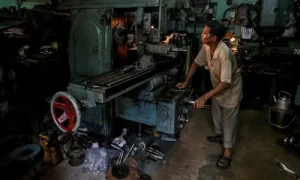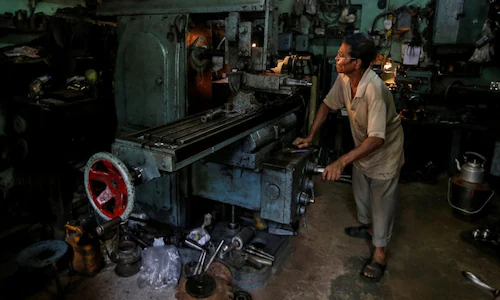Indian MSMEs worry about rising interest rates, inflation and low demand
“First came COVID, then came multiple waves of COVID, then came the war and now rising prices, it just seems like an ongoing crisis,” says Balu Agre, Director of Dreamstar India Appliances, a Pune-based MSME.
Agre’s company is one of the few MSMEs that was able to benefit due to the world’s China Plus One policy, which is a strategy to avoid investing only in China. But after COVID and the ongoing war, he is now faced with inflation and demand woes just like other MSMEs.
On the occasion of MSME Day, we try to find out the challenges MSMEs face.
India is home to around 6.3 crore MSMEs. As per IBEF data, the number of registered MSMEs stood at 80.16 lakh units as of March 31, 2022 – from that 64 percent of the registered MSMEs were service enterprises, while manufacturing covered 36 percent.
As of March 31, 2022, under the top five state-wise Udyam registrations, Maharashtra recorded the maximum number of registrations with 16.29 lakh units, followed by Tamil Nadu (8.55), Gujarat (6.48), Uttar Pradesh (6.32), and Rajasthan (6.30).
At present, soaring inflation and low demand are aching the MSMEs. Adding to it, are the rising interest rates and the temporary labor concerns.
Prashant Patel, President of the Federation of Indian Micro and Small & Medium Enterprises (FISME), said, “Raw materials prices over the last one year have doubled. However, the prices have declined but that is not even close to what it was a year ago.”
He added prices are just down by 10-15 percent after the government intervention. “If inflation continues to persist then challenging times lie ahead for the sector,” Patel said.
According to CRISIL Research’s SME Report 2022, more than a quarter of India’s MSMEs lost a market share of over 3 percent due to the pandemic, and half of them suffered a contraction in their earnings before interest, tax, depreciation, and amortization (EBITDA) margins because of a sharp rise in commodity prices last fiscal, compared with the pre-pandemic (fiscal 2020) level.
Patel said the low demand in the international market is due to the ongoing Ukraine-Russia war and the lockdown imposed in China. “The low demand in the market for most sectors, accompanied by inflation is a cause of concern. In addition, MSME exporters are unable to use the currency depreciation to their benefit. Meanwhile, as a country, the rupee depreciation is impacting our forex reserves as we are a net importer country,” he added.
By July-August, Patel hoped the market would improve and then there would be some demand. He added that according to the international market scenario, India was doing better than other countries.
“But the fact of the matter is that MSMEs are facing a lot of issues like shrinking demand and rising interest rates. We are already facing challenges related to shortages in raw materials or higher prices in raw materials. In the longer term, it will hamper the growth of MSMEs,” he said.
In August 2021, the MSME ministry announced a target to boost MSME’s contribution to the GDP to 50 percent by 2025. But the present scenario may delay this target. Data shows MSMEs contributed 30.5 percent to India’s GDP in FY19 and 30 percent in FY20.
MSMEs contribute nearly 40 percent of overall India’s exports, contributing to around 6.11 percent of the country’s manufacturing GDP. Rupa Naik, Senior Director, WTC Mumbai, said, “Shrinking demand in the US and Europe is affecting MSMEs. Though pandemic has not affected our country, it has affected consumers’ buying pattern.” Thus, affecting the traditional sectors like handicrafts and textiles, Naik added.
She added sectors like textiles, plastic, paper, and engineering are hit as they are finding it difficult to get raw materials from China, adding to it are volatile crude oil prices and rising freight costs.
Capital crunch can be a cause of concern for MSMEs in the near future – due to rising interest rates and input costs (as margins are hit due to rising input costs).
According to the data released by CRIF High Mark, the overall disbursements to the MSMEs grew 5 percent to Rs 37.29 lakh crore in FY22 compared with the year-ago period. The report added that it has more than doubled compared to FY20. The average ticket size of an MSME loan stood at Rs 72.4 lakh in FY22. Despite these growing numbers, Naik still feels capital is still a constraint for most MSMEs.
“If the government can introduce some scheme like an interest subvention scheme, it will help MSMEs,” added Patel. Currently, many MSMEs have put on hold or slowed down on investments over the fear of capital constraints.
Yet another challenge faced by MSMEs is related to labor. In May, there are a number of festivals and social functions in Uttar Pradesh, Bihar, and Jharkhand – most laborers come from these regions. So, many workmen go to their respective states of origin. Patel added after July workmen will resume work.
However, Patel added, “As an industry, we have to focus on automation and digital technology. Going forward, we will face workmen shortage.” At present, MSMEs employ around 11.1 crore people.




